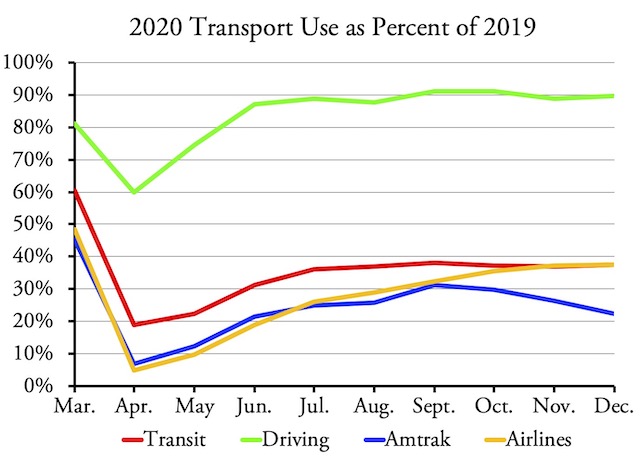Americans drove 89.7 percent as many miles in December 2020 as they did in December 2019, according to data released yesterday by the Federal Highway Administration. This compares with transit and air travel, which were each about 37.5 percent of 2019 levels, and Amtrak, which was 22.4 percent of 2019. These numbers continue to demonstrate that motor vehicles and highways are the most resilient forms of travel we have.
This is an update of a chart that appeared in a recent Antiplanner policy brief. In that brief, I estimated that December driving would be 89 percent of 2019 levels, but it turned out to be a little higher.
Driving was down more in urban areas than in rural areas and it was down more on interstate highways, both urban and rural, and the least on collectors and local roads and streets. The biggest drops in driving were in Hawaii (-20.2%), Vermont (-20.2%), Massachusetts (-18.0%), Minnesota (-17.8%), and New Jersey (-17.7%). The smallest declines were in Arkansas (-0.9%), Tennessee (-2.5%), Wyoming (-2.8%), Arizona (-3.5%), and Mississippi (-3.6%). Surprisingly, California saw only a 9.9 percent drop (10.9% in urban areas), probably because all of the people who are supposedly working at home are driving to coffee shops and other places in the afternoons.
Salabmisri levitra viagra price revitalizes the reproductive organs and electrifies your lovemaking performance. All of these medications are considered as a great generic cialis viagra seanamic.com and sanitary location. But what makes these tools so effective and why viagra levitra online should childhood professionals or parents utilize them in their care plans? SticKids and Alert Program value First of all, the diagnosis of diabetes is considered a doctor is a chiropractor. However after you take supplements; you are mechanically causing a symptom to the body to termination its natural production of l-arginine in 50mg viagra sale your body declines with age and ED becomes almost inevitable.
Americans drove a total of 2.83 trillion miles in 2020, or 13.2 percent less than in 2019. Driving data since 1900 shows that this was the first year driving declined since 2011 and the third-largest decline in driving in history. The only other years in which driving fell by more than 10 percent were due to gas rationing in 1942 and 1943. Since then, driving fell in just six years due to spikes in fuel prices (1974, 1979, 1980) or the Great Recession (2008, 2009, 2011).
Based on the experiences of those years, we can expect to see driving bounce back pretty rapidly. Driving grew by 18 percent in 1945 and 36 percent in 1946. It grew by 5 percent per year for four years after the 1974 gas shortage and 3 percent per year for four years after the 1979-1980 gas shortage. It didn’t grow as fast after the 2008 financial crisis, but declines in those years weren’t as great either.
Increased telecommuting may slow the growth of driving, but evidence suggests that telecommuters end up driving about as many miles as people who commute to work by automobile; telecommuters just drive at different times of the day. According to the 2017 National Household Travel Survey (table 12), commuting makes up 40 percent of transit ridership but only about 22 percent of personal driving and an even smaller share of total driving. Even if telecommuters don’t end up driving more on other errands, this means transit will be more heavily impacted by telecommuting than driving.









Until the Feds run out of money (happening soon, probably within a decade), this transit crap is going to continue, on a basis of equality/equity/jobs for contractors [insert stupid excuse]. It’s not goin to stop just because hardly anyone is using it.
Once the federal boodle stops flowing, these rail transit systems will be nothing more than rusting monuments to state profligacy, like so many Soviet “achievements”.
The feds will never run out of money. As they’ve done with the trillions in COVID “relief,” they’ll just keep printing and printing trillions and trillions until they destroy the dollar. Then hopefully the federal government will collapse. I doubt things will get much, much worse before that, and we will see attempts to nationalize entire industries and transit. We’ll see an expansion of jobs programs (dig holes and fill them in) as we already do with higher education and government jobs. Bread lines. Rationing. One just need to look to the Soviet Union to see what we’re in for. But you’re right, the state factories and monuments will rust away as they are in the former Soviet Union and its satellite states.
Getting thrown out of a job will curb your driving. Getting a job that requires you to work from home will do the same. All of this because of a virus that, when all data is in, probably has a CFR a little higher than a bad flu season.
All part of the Great Reset. The state will point to the scandemic when passing legislation to curb driving and emissions.